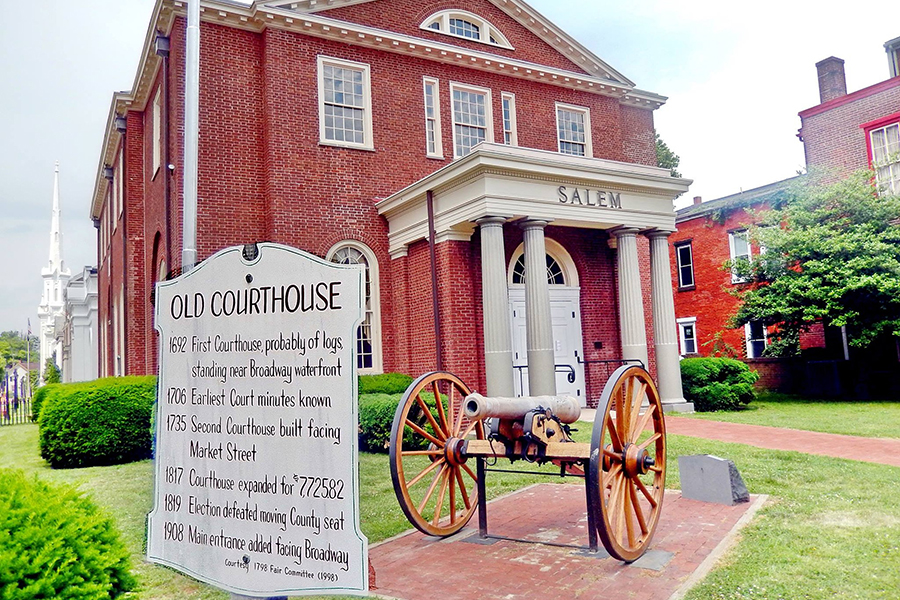Salem County – So much more than farms

Kathleen Mills wants you to look beyond the farms.
And the cows.
Beyond the verdant pastures and white fences and country life that define the bucolic splendor of Salem County, beyond all that, to see the tourism gems that beckon visitors who take time to stop and smell more than the fresh air.
There is history, plenty of it. There are museums and festivals, wineries and nature preserves, shopping in quaint towns rooted in more laid-back times, all of it easily overlooked in a sprawling rural county that is nearly 350 square miles -- nearly half of it still actively farmed -- and home to just 65,000 people, the lowest population among the state’s 21 counties.
“Sometimes I think there might be more cows than people,” Mills says, laughing. “But I can’t say I’ve taken a count.”
As the county’s tourism director, Kathleen Mills, a Woodstown resident for two decades, devotes a lot of time to encourage folks to set the car GPS for Salem County. A lot of them passing through South Jersey don’t know of the county’s charms, but a lot of them do, tending to take these charms for granted, such as the drive down a half-mile lane to the 1722 Abel and Mary Nicholson House in Elsinboro Township, one of 37 patterned-brick houses that still stand in Salem County as the architectural legacy of English Quakers who settled the region 342 years ago.
But understand this. Mills doesn’t think she’s pushing South Jersey’s version of Niagara Falls. She’s a realist. Which means she happily promotes a slice of rural paradise that is home to a spectrum of touristy things -- the history of Fort Mott, an imposing Pennsville river fortress built in 1896 in anticipation of the Spanish-American War, or the splendor of the 2,800-acre Supawna Meadows National Wildlife Refuge, or the bruising thrills of Cowtown Rodeo in Pilesgrove, or the Victorian charm of the Woodstown Candlelight Tour at Christmas.
And that’s just four things,
“I don’t have the delusion that people are going to come here and stay for a week. We don’t have the capacity for it,” says Mills, whose efforts primarily target day-trippers and regional visitors. “We’re happy if people stay for a day. It’s important to do what we can to help our hotels, to help our businesses, to boost the local economy.”
The tourism department has been wooing visitors in recent years with such crafty slogans as “Discover the Possibilities” and “Discover the Road Less Traveled.” Mills, however, was still two years from coming aboard when the promotional road to Salem County took a significant turn in 2010, as the county freeholders, with big financial support from the Salem County Improvement Authority, funneled $200,000 into a tourism budget and an aggressive marketing campaign.
The investment paid off. Salem County’s 5.84-percent growth in tourism -- second in the state that year to Gloucester County’s 6.63 percent -- translated to a $14.6 million increase in tourism spending at local attractions, hotels and restaurants, and retailers.
In the years since, the annual tourism budget has felt the severe pinch of fiscal austerity, averaging only about $15,000, but Mills has been a resourceful Salem County booster in the five years since she departed as director of operations for the Pennsylvania Horticultural Society, presenter of the yearly Philadelphia Flower Show.
“I saw the (tourism) groundwork that had been laid,” she says. “I reviewed tourism economic surveys done by the state and saw that Salem County had a big boost in tourism. We rode that for a while. The investment (by the county) has gone down as times got a little tougher -- you have to pick and choose where you put your tax dollars -- but the freeholders’ support of tourism is still there.”
In 2016, New Jersey logged its seventh straight year of growth in tourist spending and visitation since the malaise of the Great Recession. It’s a $44-billion industry that generates $4.9 billion in state and local tax revenues. It represents 6.5 percent of the state economy.
Tourists dropped a good chunk of money in Salem County as well last year. The $201 million in tourism spending represented a 1.6-percent increase over 2015, with the county gleaning about $21 million in tax revenue, Mills says.
She chases the tourist dollar with a staff of one -- herself. Her job title also makes her the county’s director of economic development and cultural affairs. And though that annual budget is even leaner -- just $5,000 in 2016 -- Mills chats about Salem County tourism with the good nature and optimism of someone who seemingly has millions to spend on commercials, marketing campaigns and brochures.
She doesn’t. But she does have a corps of reliable volunteers to help with publicity and marketing. Social media is a key platform. And so is enlisting the help of agencies like the New Jersey Chamber of Commerce and the New Jersey Division of Travel and Tourism to spread the word about Salem County.
“Are we trying to let the world know about us? No,” she says. “We have to be more regional. Our aim is to get people to enjoy Salem County and spread the word. We need their word of mouth. We need them to share their experiences on Facebook and other social media.”
There’s enough to talk about. Cowtown Rodeo’s more than 60-year existence in Pilesgrove Township has put the county on the tourism map. The expansive Parvin State Park is a nature lover’s paradise. The picturesque Finn’s Point National Cemetery in Pennsville, recorded on the National Register of Historic Places in 1978, is the burial site of Union soldiers and Confederate prisoners who died at Fort Delaware during the Civil War. The mighty Salem Oak, rising above the Salem Friends Burial Ground on West Broadway, is alive and kicking at 565 years of age, and local lore tells us that English Quaker John Fenwick, who settled the region, had an affinity for the majestic shade tree upon his arrival in 1675.
The diverse attractions have been supplemented by a burgeoning roster of annual events that are high-profile destinations for county visitors. Every Labor Day weekend, about 6,000 music fans head to the wide-open Salem County Fairgrounds in Pilesgrove for the Delaware Valley Bluegrass Festival. Each June, the fairgrounds is the site of the popular Nanticoke Lenni-Lenape Pow-Wow, a two-day celebration of culture, native artistry, and food.
“Our ‘Arts In Bloom’ is very popular,” Mills says of the two-day May event, which showcases Salem County artists and studio tours. “Our hope is that perhaps someone stays for both days and enjoys the experience of driving through our county and seeing how beautiful it is, and maybe that experience will bring them back.”
At the moment, Mills is preparing to stage the county’s first “familiarization tour,” a junket that’ll be held in May to introduce business reps, state tourism officials and media members to the sights and slices of life in Salem County.
She’ll point out all it has to offer. And, yes, she won’t overlook all those cows and pastures.
“We try to use it as an asset. That’s what we are, and we like that,” Mills says. “It helps us to promote Salem County as a place to get away from it all and experience something different.”
(Find out all that Salem County has to offer by visiting www.visitsalemcountynj.com or emailing tourism director Kathleen Mills at kathleen.mills@salemcountynj.gov)






